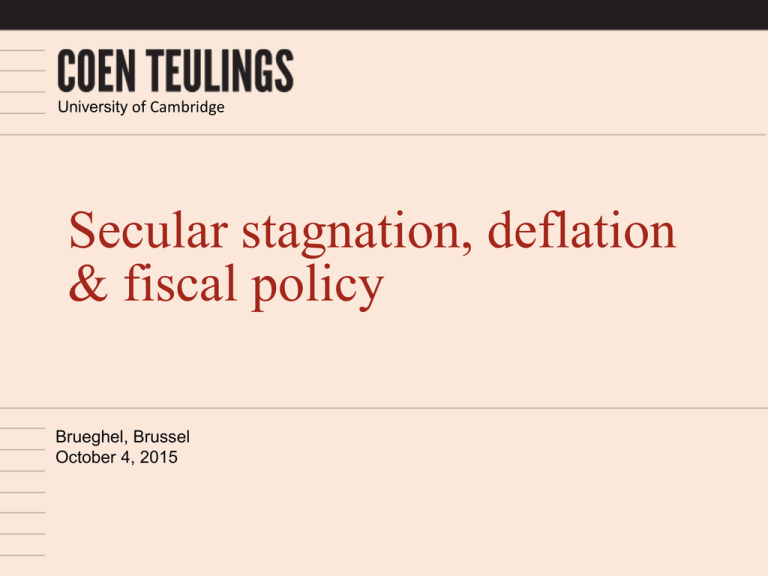Presentation - Coen Teulings
advertisement

University of Cambridge Secular stagnation, deflation & fiscal policy Brueghel, Brussel October 4, 2015 Larry Summers There is increasing concern that we may be in an era of secular stagnation in which there is insufficient investment demand to absorb all the financial savings done by households and corporations, even with interest rates so low as to risk financial bubbles. Boston Globe, April 11, 2014 Secular Stagnation, deflation & fiscal policy ◼ Menu of the day 1. 2. 3. 4. 5. 6. What causes Sec Stag? Its consequences Options for absorption of excess savings Global or regional phenomenon? Low real rates, deflation, and Japan Fiscal Compact 1. What causes Sec Stag? 1. Supply of loanable funds? Sure 1. 2. 3. 4. 2. Demand for loanable funds? Maybe 1. 2. 3. China (1% of world GDP) Savings glut: root cause of financial crisis? Demography Japan, China, Germany Lower growth Rise of IT industry Excess demand for save assets? Sure Demography and supply of funds Demand for funds ◼ Increasing share of IT in total market cap Take top 100 public companies ◼ Exclude financials to avoid double counting ◼ IT (including Amazon) accounts for 25% ◼ ◼ Investment demand probably limited Network rents ◼ High margins for low investment activities ◼ Shortage of safe assets 2. Its consequences: low real interest rates Zero lower bound ◼ Low real interest rate required for equilibrium ◼ Zero lower bound to nominal interest rates ◼ Classical case of a liquidity trap ◼ Low inflation worsens the problem ◼ Excess risk aversion by regulators 3. Options for absorption of excess saving 1. Raising the retirement age 2. PAYG benefits 3. One time increase in sovereign debt 4. Bubbles: risky? 5. An external surplus: risky? 6. A severe Keynesian recession: surely bad! What about bubbles? ◼ What is a bubbly asset: price > NPV future returns ◼ Jean Tirole’s theory of rational bubbles: r < g ◼ Why? ◼ ◼ ◼ ◼ Fixed supply of bubbly assets When savings grow at rate g, so do bubbly assets → bubbly assets more attractive than investment Dynamic inefficiency: too low investment demand ◼ Analogies: Aaron: PAYG vs. funded pensions ◼ The reverse of Thomas Piketty Consider an island economy Overlapping generation model 1. Case: no stores of value ◼ ◼ 2. Consumption = production (by definition) PAYG, sovereign debt, and bubbles equivant Case: capital as a store of value ◼ ◼ ◼ ◼ ◼ Young invest; old can sell their investment Requires a sufficient demand for capital … such that r > g Again: PAYG, sovereign debt, and bubbles Conclusion: limits to physical stores of value Bubbles and demography ◼ ◼ ◼ ◼ ◼ Bubbles require r < g Fall in fertility lowers g Hence: less chance on a bubble? No: non-steady state situation ◼ Fall in fertility occurred around 1970 ◼ Last big cohorts now in their ‘60 ◼ Heavily saving Non-steady state theory of bubbles (Teulings 2015) ◼ Bubbles achieve intergenerational transfers ◼ Fiscal policy needed for intragenerational transfers House price in Britain ... and France What about Germany? A German fear Is the German fear legitimate ◼ ◼ ◼ On the one hand: NO! ◼ Bubbles are inevitable in a world with Sec Stag ◼ Needed for absorption of excess saving ◼ … and for intergenerational transfers On the other hand: Yes ◼ Low real rates complicates valuation of assets ◼ More volatility, bubbles might collapse But either PAYG or higher sovereign debt 4. Global or a regional phenomenon? ◼ In a world with an integrated capital market ◼ ROW will absorb excess saving, e.g. ◼ ◼ ◼ ◼ ◼ ◼ Unless Sec Stag is global Though: Eggertson, Mehrotra, Summers (2015) But: Feldstein-Horioka paradox But: disintegration of global capital market ◼ ◼ China’s purchase of US treasuries Germany’s investment in Spanish housing Despite banking union, even within Europe Hence: Sec Stag requires European policy 5. Low real rates, deflation, and Japan ◼ Why worry about deflation? Zero lower bound! ◼ Economists’ problem: Why didn’t it happen? ◼ ◼ ◼ ◼ Theoretical responses ◼ ◼ ◼ ◼ Both in Japan and Europe: only little deflation Demise of Phillips curve: steep deflation, Excess capacity both of capital and labour Fiscal theory of the price level: problematic John Cochrane: low inflation due to low rates Bob Hall: equilibrium with more uncertainty None of them undoes main advice: ◼ Absorb the excess saving Japan’s experience ◼ What happened to Japan? ◼ ◼ ◼ Maybe we can live with low inflation ◼ ◼ As long as we absorb excess saving by sovereign debt: Japan’s stand at 200% GDP+ We ask the wrong question ◼ ◼ ◼ Lost decade? Low growth? Its GDP per capita grow reasonably well Wrong: why runs the government a high debt? Right: why want the public to hold this debt? Provided that it is hold domestically 6. Fiscal Compact ◼ Current system problematic Uncredible: countries should reduce their debt by 5% of the excess above 60% GDP 1. ◼ For Italy: 3% per year Undesirable: structural deficit at 1% GDP 2. ◼ ◼ ◼ Implies a long run debt of 33% GDP … assuming 3% nominal growth Inconsistent with savings in Germany Problem and potential solution ◼ States in monetary union cannot run high debt ◼ ◼ ◼ But if so, federal debt needed to absorb savings ◼ ◼ ◼ See US experience In that sense, rules are fine See US See Japan The European challenge Secular stagnation: Implications for the Eurozone Democracy and macro policy Richard Koo on balance sheet recessions: “Democracies are ill-equipped to handle such recessions. For a democracy to function properly, people must act based on a strong sense of personal responsibility and selfreliance. But this runs counter to the use of fiscal stimulus, which involves depending on ‘big government’.”








